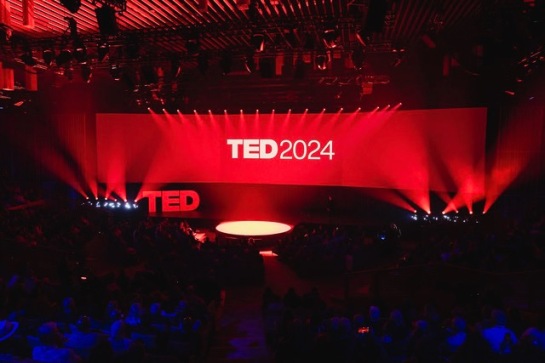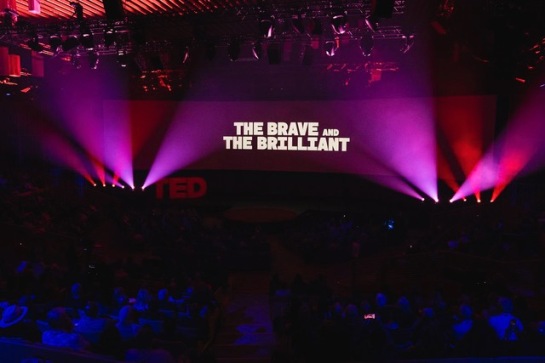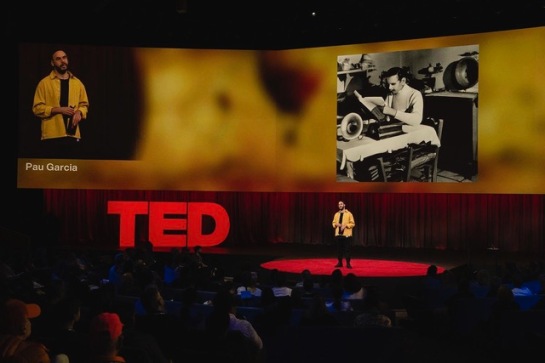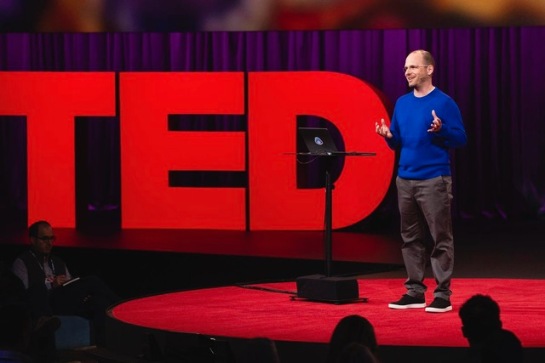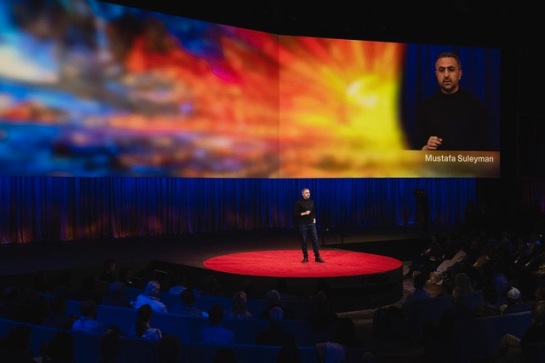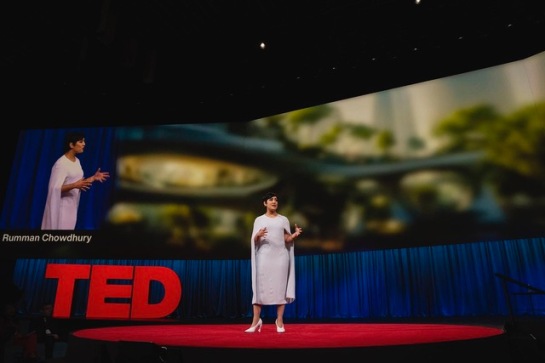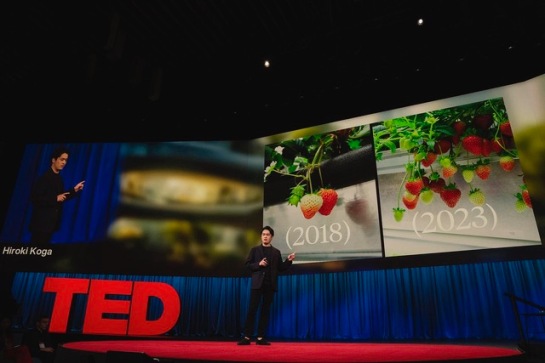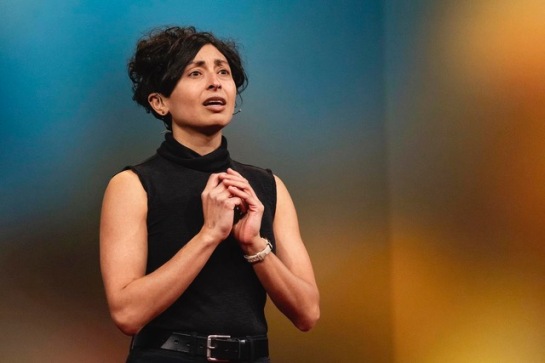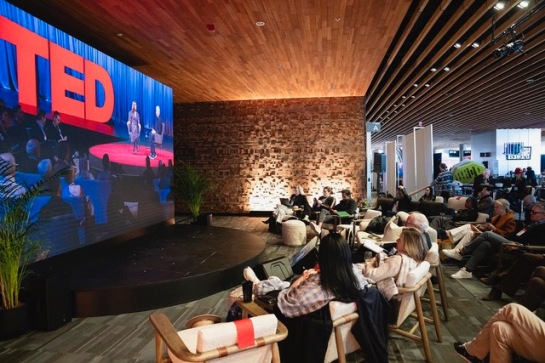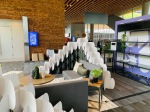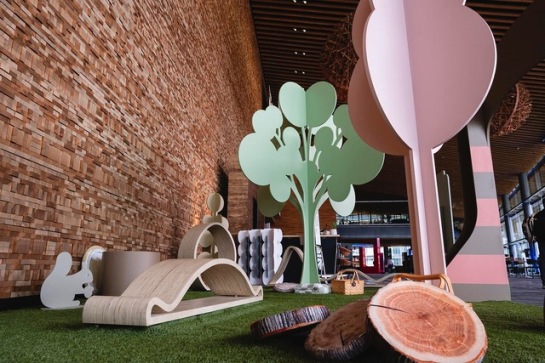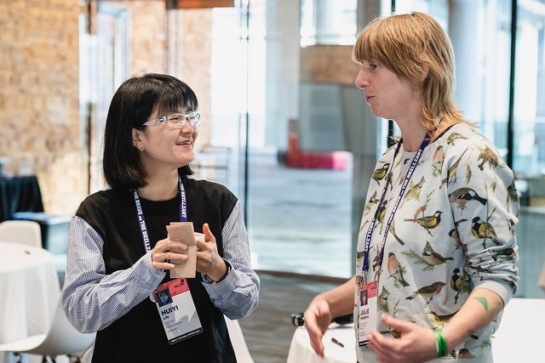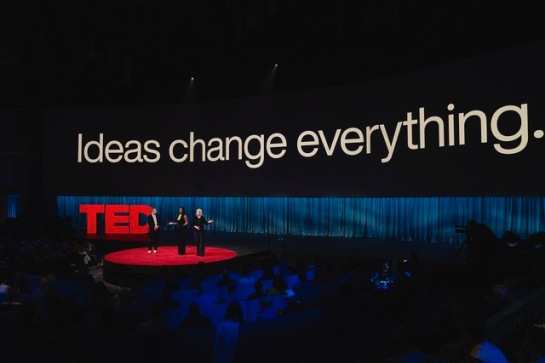TED 2024 – The Brave and the Brilliant
TED 2024 – The Brave and the Brilliant
29 April 2024
This April, I was fortunate to attend the TED conference in beautiful Vancouver. It was celebrating its 40th anniversary and the theme was “The Brave and the Brilliant.” Having delivered two TED talks over the years, it was amazing to finally be amongst the global community of 1700 thinkers, innovators, and creators at the main TED conference.
This year’s conference was particularly notable for its emphasis on artificial intelligence, which dominated discussions across various sessions. Indeed my own panel, which I have written about here, focused on the challenges and opportunities AI creates for design and art-making. Alongside the many talks on AI, the conference also made significant room for a broad range of scientific, technological, and artistic presentations, ensuring a well-rounded exploration of many of today’s most pressing issues.
Alongside the talks, the conference excelled in experience design, offering attendees immersive environments, simulcast lounges, interactive art installations, and amazing local coffee. This blend of thought leadership and sensory experience made TED2024 an intense and inspiring experience, and I’ll share a few reflections here.
1. All About AI
TED 2024 was abuzz with discussions on artificial intelligence, and its transformative impact across industries and society. The prominence of AI in numerous talks led one conference attendee to play “conference bingo” noting AI was mentioned a total of 300 times across the five days of the conference.
Stand out talks for me included that of Daniela Rus, Director of the Computer Science and Artificial Intelligence Laboratory (CSAIL) at MIT. Her striking talk discussed the integration of AI with robotics through the development of “liquid neural networks” a new paradigm destined to make AI more flexible, efficient, and sustainable. This approach aims to break down the silos between robotics and AI, envisioning a future where bespoke machines seamlessly integrate into daily life to enhance human capabilities and experiences. Her talk is online here:
She explained how liquid neural networks are inspired by the relatively simple nervous system of the nematode made famous by Nobel laureate, Sydney Brenner, C elegans.
Using far fewer artificial neutrons than traditional AI, “liquid networks” can adapt their operations in real-time. This innovation allows for more responsive and efficient AI systems, capable of handling complex tasks like autonomous driving by adjusting their behaviour based on immediate environmental input. Rus highlighted the potential of these networks to transform many fields, as they can react more naturally and swiftly to changing conditions. There’s a detailed analysis of this work on Quanta.
Fei-Fei Li, another luminary of the field is AI, is Professor of Computer Science at Stanford University and Co-Director of Stanford’s Human-Centered AI Institute. She captivated the audience with her insights into the evolution of AI with “spatial intelligence.” Her discussion focused on the critical importance of sight and spatial awareness in robotics, arguing for the development of machines that can understand and interact with their environments in three-dimensional space. This kind of spatial intelligence, she posited, could significantly enhance the utility of robots in complex, real-world settings across various sectors.
Pau Garcia, Founder at Domestic Data Streamers from Barcelona, delivered a great presentation offering a poignant exploration of AI’s potential to touch human lives. Garcia introduced a novel application of AI designed to capture and translate personal memories and emotional experiences for people suffering with dementia or other losses. The Synthetic Memories Project uses AI to preserve personal histories and to create soulful, dynamic representations of human experiences that can be shared and understood across different cultures and generations. Garcia’s talk was a beautiful reminder of AI’s capacity to serve not just functional or analytical roles but to enrich our understanding of the human condition.
The conference also featured talks by tech giants including Demis Hassabis, Co-founder and CEO of Google DeepMind. Hassabis, a former chess prodigy, began coding from a young age, which laid the foundation for his later work in AI and game development. His fascination with games evolved into the development of AlphaGo, a programme that famously defeated world champion Lee Sedol in the complex game of Go. This achievement was not just a milestone in AI but also a stepping-stone for further innovation, such as AlphaFold. This tool addressed one of biology’s most enduring challenges: predicting protein structures. AlphaFold’s ability to predict these structures with remarkable accuracy has opened up new possibilities in medicine, particularly in understanding diseases and accelerating drug discovery.
This work exemplifies the potential of AI to drive significant scientific advances, showcasing how AI research can transition into practical applications that may revolutionize our approach to health and disease. Hassabis memorably suggested that while today’s science “sees only a few limbs of the tree of knowledge, AI could allow us to see the entire tree one day”.
Thomas Dohmke, CEO of GitHub, spoke about how AI is transforming software development. In a warm, charming talk, he described Github as the place that the “chief nerds of society collaborate on code.” He described the emergence of large-language models (LLMs) as the most profound development for software creation since programming began. He noted that thanks to tools like ChatGPT and his own company’s Copilot, he is expecting to see an explosion in the number of software developers creating code. Right now, there are 100 million developers on Github, but by 2030, he is anticipating that will rise to 1 billion. He also gave a wonderful demonstration of Github’s new tool, Copilot Workspace. GitHub’s original Copilot is an AI-powered tool that assists programmers by suggesting lines of code or entire functions. Copilot Workspace is designed to take this to the next level by automatically generating plans and code across entire repositories. It uses AI to understand both the task’s intent and the specifics of the codebase, allowing for adjustments in behaviour, plans, and code through a user-friendly interface. Copilot Workspace shows how AI is transforming the software development landscape by making coding far more accessible.
Mustafa Suleyman, Co-founder of DeepMind and new CEO of Microsoft AI, explored the concept of AI as a new “digital species” discussing its implications for future human-machine interactions. His talk is online:
Special mention should be made of Anima Anandkumar, previously Senior Director of Machine Learning Research at NVIDIA and currently Professor of Computing at Caltech, who is pushing the boundaries of AI by teaching it the fundamental rules of physics and chemistry. A pioneer of Neural operators, a class of deep learning architectures designed to learn maps between function spaces. Her work aims to use AI in practical applications for creating real-world objects, including medical devices, demonstrating the tangible benefits of AI in enhancing human health and capabilities.
TED2024 painted a picture of a future shot through with AI. Sometimes the presentations soared into the realms of techno-utopian dreams and became a little breathless in their depiction of a rosy future dominated by AI solving humanity’s problems. But other times more cautious voices reminded the audience of the need for guardrails and regulation. Helen Toner, who left OpenAI’s board after failing to oust Sam Altman, called for AI companies to be open to measurement, disclosure and incident reporting, whilst Rumman Chowdhury, the AI ethics specialist who ran the “red team” testing at DEF CON, argued for a “right to repair” for AI, allowing people to find and fix the flaws in systems. Overall, there was no doubt, we all left better informed of the immense possibilities and the ethical challenges posed by advancements in AI.
2: Scientific Frontiers
Beyond the discussions on AI, TED2024 showcased an array of scientific topics from speakers from fields as diverse as plasma physics to genomic sequencing and many points in between.
My favourite talk was by Indigenous scientists Cliff Kapono and Keolu Fox from Hawai‘i. They spoke eloquently and entertainingly about their unique work that blends traditional knowledge with cutting-edge science. Their talk focused on using DNA as a data storage mechanism. They were the only presenters in the conference to talk about the energy implications of large scale AI, and their proposed solution is ingenious. They plan to use local plants, specifically sugarcane, to store data describing these data storage plants as “Sugar Drives”. Their approach embodies a powerful message about decolonization and environmental work. Kapono and Fox talked about the potential of biotechnology to aid in local land conservation efforts and address climate change. Their unique integration of indigenous knowledge with modern science was a compelling call to rethink how we interact with technology and the environment. You can read more about their approach to intertwining Indigenous knowledge with synthetic biology to restore Hawai‘i’s ecology in this article from 2022.
I was also very pleased to see a highly controversial area of science, geo-engineering, tackled by TED. Sarah J. Doherty, Programme Director of the Marine Cloud Brightening Programme at the University of Washington Seattle. She discussed the potential of marine cloud brightening as a climate intervention tool, something that deeply divides climate scientists. Her timely presentation into the science of manipulating cloud formations to reflect more sunlight away from Earth provided an important look at the possibilities and challenges of geo-engineering as a means to mitigate global warming effects. Sarah is brave amongst scientists. There are few scientists who are willing to investigate this type of controversial science, but without research it will be difficult to know how to effectively regulate and govern geo-engineering technology as it becomes more needed.
Sarah is also involved in field measurements of atmospheric aerosols and is part of the NASA ORACLES project, which is quantifying how biomass burning aerosol from agricultural fires across south-central Africa affect climate, both through direct scattering and absorption and by affecting clouds over the southeast Atlantic Ocean.
One of the best ways of mitigating climate change would be to identify better sources of energy than the ones we use today. The mecca of such energy sources is nuclear fusion. Tammy Ma is a veritable household name in the field of fusion research. She leads the Inertial Fusion Energy Institutional Initiative at the Lawrence Livermore National Laboratory, and shared the latest advances in the quest for sustainable fusion energy. Her enthusiasm and detailed explanation of the technology – and funding – required to achieve controlled thermonuclear fusion were both educational and hopeful, offering a vision of a future with a virtually limitless clean energy source. Let’s hope her dream becomes our reality.
Elsewhere in the programme, innovations within food systems were highlighted by Hiroki Koga, a vertical farming entrepreneur and founder of Oishii. His talk provided us with a look at the state-of-the art within vertical farming, demonstrating how controlled-environment agriculture could revolutionize the way we grow food, making it more sustainable, efficient and tasty! His talk on Oishii’s work with strawberries was fascinating and underlined the importance of continuing to fund research into innovation in agriculture.
Genetics, public health and the future of medicine were key topics at TED2024. Perhaps the most extraordinary talk in this category came from Katsuhiko Hayashi a professor in the department of genome biology at Osaka University in Japan. He leads the team that generated viable mouse eggs from the skin cells of two biologically male parents. With this research, he has rewritten the rules of sexual reproduction by creating living mice from two male parents, something that science thought was impossible. This work challenges conventional biological paradigms and offers new avenues for research in genetics and reproduction.
Hayashi is also pioneer of in vitro gametogenesis, an exciting, experimental and ethically fraught field that could bring species back from the brink of extinction. Hayashi’s work promises to expand our understanding of life’s complexities, and his presentation at TED2024 was a revelation. You can read more about his extraordinary mice here.
Also on the topic of health, Abdoulaye Diabaté brought critical insights into the fight against malaria in Africa, where 95% of the world’s malaria deaths occur. He is the head of medical entomology and parasitology at the Research Institute in Health Sciences in Bobo-Dioulasso, Burkina Faso, and the principal investigator of Target Malaria Burkina Faso. At TED2024, he presented his groundbreaking work with Target Malaria which involves genetically modifying mosquito populations in order to reduce malaria transmission. Whilst the technology is ready for deployment, Diabaté noted that community consultation was essential for the science to be effective. His talk – and Hayashi’s – highlighted the tension between the incredible possibilities of genetic science and public health. Both emphasized the need for ethical, political and social consultation and community-focused strategies for implementing new science in the realm of public health.
Unquestionably one of the standout presentations at TED2024 was by Sonia Vallabh. She runs the prion research laboratory at the Broad Institute at MIT and Harvard, which is researching potential treatments or cures for human prion diseases — fatal neurodegenerative diseases caused by the spread of misfolded proteins throughout the brain. Vallabh has turned her personal tragedy into a scientific crusade against prion diseases. Her deeply personal and emotional talk showcased her journey from novice to neurodegenerative specialist, driven by the urgency to find a cure for the disease that took her mother’s life.
These talks exemplify the diversity of thought at TED, although there were many others I could have highlighted. Whilst they gave hints at the implications of these scientific advancements for society at large, it would have been wonderful to have dug a bit deeper on many of these topics. I will be reading, and re-reading the notes I took from these and other talks for months to come, I suspect.
3: Provocation
Despite the overall techno-optimistic mood, TED didn’t shy away from difficult issues. The Israel-Hamas war loomed large and was emotionally addressed several times in the conference. The theme of social and political polarization, particularly relevant to the majority-American attendees, was also explored, highlighting the deep divides affecting communities in North America.
An attempt to address these political divides in Session 5: Provocateurs illustrated the challenges of staging divisive and triggering discussions. Talks that were perhaps curated with the intention of provoking thought and bridging gaps, ended up highlighting the difficulties of addressing such divisions within a diverse audience. The session, whilst well-intentioned, sparked controversy and caused pain and division, serving as a real-time example of the polarization it aimed to combat.
4: Designing Delight
On the other end of the spectrum, art and culture balanced often heavy discussions injecting much needed joy and levity to the proceedings. On the main stage, Singaporean artist, Niceaunties, offered a playful and insightful look into Asian “auntie culture” through digital art. She uses AI to craft vibrant scenes that celebrate elder women in unconventional, joyous settings. Her talk is online now:
And legendary Chinese artist, Cai Guo-Qiang gave an ebullient talk about his unique and dramatic approach to art, which uses fireworks and gunpowder. His talk was notable as he spoke in Mandarin and was live-translated by an AI mimicking his voice. It was the first time TED had allowed a non-English speaker to present on the main stage, and it was a welcome addition.
Showing that art can also be usefully confrontational, David Finnigan, a playwright from Australia, gave an excellent talk about his provocative play, Kill Climate Deniers. The play’s storyline features eco-terrorists taking over Australia’s Parliament House during a Fleetwood Mac concert to demand action against climate change. Finnigan discussed how the play, described as “gleefully anarchic” uses satire and a high-energy narrative to challenge the audience’s perceptions of political and environmental urgency. The play has sparked significant discussion and controversy, reflecting Finnigan’s aim to provoke thought and inspire debate on the global issue of climate change. He gave a consummate performance of perfectly executed storytelling, got a standing ovation, and was later called out by Al Gore for his innovative approach to raising awareness of climate change.
Off the stage, one area that TED really excels in is experience design. TED2024 was replete with truly delightful experiences for attendees, created by designers, artisans, architects, artists and culinary craftspeople. The TED Theatre itself is something of an architectural marvel. It is custom-made especially for TED and is the perfect environment to sit through five days of talks. Around the Theatre is “The Loop”, an array of beautifully-designed sitting areas, work spaces and simulcast lounges that allow participants to relax, work, or enjoy talks away from the intensity of the Theatre.
- The Loop at TED 2024
- The Loop at TED 2024
The lounges, relaxation spots and bookshop were complemented by pop-up talks and interactive sessions enhancing the communal and exploratory spirit of the conference. The creatively designed Fellows Park shone a light on the brilliant work of some of TED’s 500 Fellows (more on them below). And the attention to local culture and sustainability in the food and beverage offerings was really great to see, with local coffeemakers giving us a taste of Vancouver’s famed cafe culture.
The experience design at TED2024 reached its peak at a spectacular circus-themed party on the Thursday evening, which was a vibrant mix of entertainment, art, and social interaction, embodying the spirit of community and celebration that defines TED.
Art installations also played a key role in enriching the sensory experience for attendees to the conference. The highlight was undoubtedly the landmark immersive artwork, Evolver by Marshmallow Laser Feast. The multi-award-wining installation guides visitors on a journey through the human body, following the flow of oxygen from inhalation to the micro-level of cells. It begins with a deep listening meditation, narrated by Cate Blanchett, and continues with large-scale projections which allow visitors to experience the subtle and critical rhythms of life in an evocative and educational manner. At TED2024, it exemplified how art together with science can make complex physiological processes accessible and engaging through breathtaking visuals and sound.
Meanwhile, Julie Freeman‘s new sound sculptures, Shaped Sound, in Fellows Park added a different kind of experiential dimension to TED. Freeman, a Senior TED Fellow, took music and sound created by other TED Fellows and embedded these sonic textures into a series of wooden sculptures. To listen, visitors had to physically “drape” themselves onto the body-sized sculptures, or nestle inside them, creating an unusual and intimate listening experience. Freeman’s work typically involves the use of real-time data streams to create art that allows audiences to perceive hidden environmental processes. By listening to data, visitors can engage with environmental issues in a novel way. I had the great pleasure of moderating a conversation with Freeman in Fellows Park, where she discussed her new sculptures, and her work in general, which elegantly fuses of art, science, and nature.
5. The Secret Sauce?
Speaking of TED Fellows, TED has a fellows programme that supports the career and work of a diverse range of scientists, artists and changemakers around the world. There are over 500 Fellows working in disciplines that range from bioengineering, medicine, physics, art, conservation, design and a myriad of other fields.
My interactions with the Fellows were among my most magical and meaningful moments at TED2024. Highlights included a wonderful public conversation with Julie Freeman in Fellows Park, and a truly inspiring meeting with Usman Riaz, who gave me a sneak peak of the first hand-drawn animated feature to be made in Pakistan, The Glassworker.
Engaging discussions with astronomer Sarah Rugheimer, public health expert Alanna Shaikh, artist and economist Huiyi Lin, comedian Negin Farsad and human rights activist Yana Buhrer Tavanier, were all equally enlightening.
The brilliant main stage talks by Fellows Keolu Fox, Anjan Sundaram and Aziz Abu Sarah left a lasting impression, and emphasized the powerful and impactful contribution that this vibrant community makes to the conference.
My encounters with the Fellows made me appreciate how crucial they are in bringing diverse perspectives and critical insights to the spirit and substance of TED. Overall, I was left the impression that the TED Fellows may be the secret sauce of TED.
6. TED: An Excellent Adventure
My five days at TED2024 were extraordinary, illuminating and at times overwhelming. I watched something like 75 talks alongside 1700 handpicked attendees, and 80 speakers. I attended several Discovery sessions – including my own Spotlight Conversation, visited all the art installations, went to several delectable dinners and lunches, and had countless mind-expanding conversations. And all this was set against the stunning backdrop of Vancouver, surely one of the most beautiful cities in the world. The intense experience of exploring the frontiers of AI, witnessing breakthroughs in science, and delighting in exceptional experience design has been incredibly enriching. TED is indeed an excellent adventure, and it has left me inspired and keen to translate what I’ve learned into my work, further developing a community engaged with the confluence of art, science, and technology.
I am truly grateful to TED community for welcoming me so warmly this year, including curatorial staff, Helen Walters and Chee Pearlman, plus Anna Bulbrook and David Biello from afar. Thank you also to long-time TED community members, especially Juan Enriquez and Pamela Meyer, who were so generous with their time and network.
